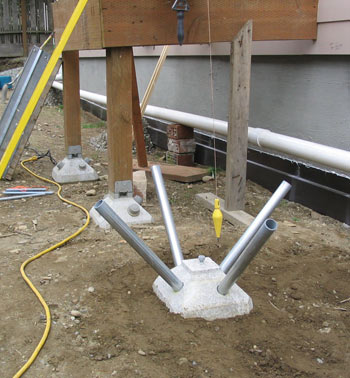Post and Pier foundations
Although most every building has a foundation of some sort running around the entire perimeter, it's not necessary to do so. The alternative it to use some number of piers, typically spaced on an even grid (for example eight feet apart) and hold the building up with these, although it doing this concentrates the building's weight on a smaller area of the ground, and hence ask each individual pier to hold more weight than the equivalent area of foundation would. There are a variety of reasons to do this: if building site is on a steep slope and for some reason a foundation is impractical, if you are building on bedrock, if you want to leave some (or all) of the ground under the building undisturbed, or because you're in a floodplain and you want to build above flood level1. Another reason might be because you're in a very remote location and bringing a cement truck in is impossible (mixing it in a hand mixer means its impossible to pour it all at once, which would leave your slab with many joints in it).
There are two factors that determine the number of piers you'll use: the compressive strength of the pier (ie how much weight it can hold up) and the size of the beams you're willing to use (the further apart the piers are, the larger the beam you will need). The strength of the pier is generally not the strength of the pier itself, but of the soil underneath it. If just the strength of the concrete were the issue, concrete foundations would be huge overkill. A typical 6" wide foundation made with standard 3000psi concrete for a typical house with about 100 linear feet of foundation (ie 1200 inches), could theoretically hold up millions of pounds, while a house is only in the tens of thousands of pounds range.
There are two typical ways to build piers: the first would be use posts and the other would be to use pins.
Posts
Because posts must be in the ground they are typically made of concrete, although some kind of treated wood could be used also. In either case, if the soil isn't compact enough, you may need to dig a wider hole and pour a footing under the post (or potentially use rubble, although you will need to thoroughly compact it!) If you're using concrete posts, there are readily available round forms in various diameters available at concrete suppliers. In the top of each concrete post you will put a U-bracket of some sort (like the kind used on outdoor decks), and the beams will sit in the U-bracket.
Pins

Pin foundation for a porch
Pins foundations consist of a special bracket that metal pipes ("pins") are driven down thru at different angles. Because of the varying angles, the pin foundation spreads the weigh from above over a large area of ground, essentially converting a downward, compressive force into a combination of compressive and bending forces. Unlike a tripod where the wide stance of the legs are for stability, the point of a pin foundation is to spread the point load from above over the entire length of all of the pins. The concrete pin holder (see photo at right) is like a little pier itself, and would suffice if the soil were hard enough. In this case, the pins are being used to reduce the amount of concrete needed for the pier to less than 1/4 of what it otherwise would have been.
The biggest advantage of pin foundations in easily compacted soils (they wont work hard or rocky soils) is that there is little disturbance to the ground: you set the pin holder right near the surface and just drive the pins in. The biggest disadvantage is in the unknown durability of the pins: once the pins weaken from rust, the whole thing gives way. A potential further disadvantage is that pin piers are designed to hold pressure treated wood, which itself may have a limited durability (in addition you have decide whether environmentally, you'd prefer treated wood or concrete).
Other considerations
Once you've decided on your pier system, you need to decide how high your posts will be, that is how high off the ground the house will be. If you're in a floodplain that decision is somewhat straightforward, but otherwise you need to decide if you're building essentially a crawl space, ie you will enclose the space underneath the house, or if you will leave the space under the house open. In either case, a disadvantage of post-and-pier foundations is that you no longer have ground temperature (which is more moderate year round) under your house and so your insulation requirements become essentially the same as your walls. Although the underside of the house isn't directly exposed to the rain (ie the house acts like an umbrella for it), you still want to treat is as being exposed, and so the bottom should be fully weatherproofed. The beams themselves may be left exposed, but all the precautions and maintenance for exposed beam applies to these.
Summary: For special situations there are really no other choices, but the loss of storage underneath, the loss of built-in thermal mass for passive solar and the lack of familiarity with the method limits it use in the more normal situation.
Notes
1: You could argue that you shouldn't be building on such sites, but since this website is attempted to avoid being judgmental, no such argument will be made here.
